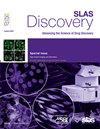A secretome screen in primary human lung fibroblasts identifies FGF9 as a novel regulator of cellular senescence
IF 2.7
4区 生物学
Q2 BIOCHEMICAL RESEARCH METHODS
引用次数: 0
Abstract
Senescent cells contribute to the pathogenesis of idiopathic pulmonary fibrosis (IPF), a disease with significant unmet need and therefore, there is an interest in discovering new drug targets that regulate this process. We design and perform a phenotypic screen with a secreted protein library in primary human lung fibroblasts to identify modulators of cell senescence. We identify FGF9 as a suppressor of several senescence phenotypes reducing stimulated p21 expression, enlarged morphology, DNA damage and SASP secretion, which is consistent with both DNA-damage and ROS induced senescence. We also show that FGF9 reduces fibroblast activation in both healthy and IPF fibroblasts shown by a reduction in pro-fibrotic markers such as α-smooth muscle actin and COL1A1 mRNA. Our findings identify FGF9 as a suppressor of both senescence and fibrotic features in lung fibroblasts and therefore could be targeted as a new therapeutic strategy for respiratory diseases such as IPF.
原代人肺成纤维细胞的分泌组筛选发现FGF9是细胞衰老的一种新的调节因子。
衰老细胞参与特发性肺纤维化(IPF)的发病机制,这是一种尚未得到满足的疾病,因此,发现调节这一过程的新药物靶点是一种兴趣。我们设计并使用原代人肺成纤维细胞分泌蛋白文库进行表型筛选,以鉴定细胞衰老的调节因子。我们发现FGF9是几种衰老表型的抑制因子,可减少受刺激的p21表达、形态扩大、DNA损伤和SASP分泌,这与DNA损伤和ROS诱导的衰老一致。我们还发现,FGF9降低了健康和IPF成纤维细胞的成纤维细胞活化,表现为α-平滑肌肌动蛋白和COL1A1 mRNA等促纤维化标志物的减少。我们的研究结果确定FGF9是肺成纤维细胞衰老和纤维化特征的抑制因子,因此可以作为呼吸系统疾病(如IPF)的新治疗策略。
本文章由计算机程序翻译,如有差异,请以英文原文为准。
求助全文
约1分钟内获得全文
求助全文
来源期刊

SLAS Discovery
Chemistry-Analytical Chemistry
CiteScore
7.00
自引率
3.20%
发文量
58
审稿时长
39 days
期刊介绍:
Advancing Life Sciences R&D: SLAS Discovery reports how scientists develop and utilize novel technologies and/or approaches to provide and characterize chemical and biological tools to understand and treat human disease.
SLAS Discovery is a peer-reviewed journal that publishes scientific reports that enable and improve target validation, evaluate current drug discovery technologies, provide novel research tools, and incorporate research approaches that enhance depth of knowledge and drug discovery success.
SLAS Discovery emphasizes scientific and technical advances in target identification/validation (including chemical probes, RNA silencing, gene editing technologies); biomarker discovery; assay development; virtual, medium- or high-throughput screening (biochemical and biological, biophysical, phenotypic, toxicological, ADME); lead generation/optimization; chemical biology; and informatics (data analysis, image analysis, statistics, bio- and chemo-informatics). Review articles on target biology, new paradigms in drug discovery and advances in drug discovery technologies.
SLAS Discovery is of particular interest to those involved in analytical chemistry, applied microbiology, automation, biochemistry, bioengineering, biomedical optics, biotechnology, bioinformatics, cell biology, DNA science and technology, genetics, information technology, medicinal chemistry, molecular biology, natural products chemistry, organic chemistry, pharmacology, spectroscopy, and toxicology.
SLAS Discovery is a member of the Committee on Publication Ethics (COPE) and was published previously (1996-2016) as the Journal of Biomolecular Screening (JBS).
 求助内容:
求助内容: 应助结果提醒方式:
应助结果提醒方式:


